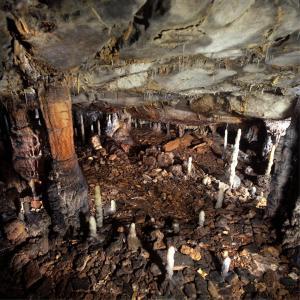
PLOS—Upper Paleolithic humans may have hunted cave lions for their pelts, perhaps contributing to their extinction, according to a study* published October 26, 2016 in the open-access journal PLOS ONE by Marián Cueto from the Universidad de Cantabria, Spain, and colleagues.
The Eurasian cave lion, likely among the largest lion species ever to have lived, became extinct around 14,000 years ago, but the reasons for its disappearance are not clear. Upper Paleolithic humans were previously known to have hunted other small and large carnivores, but archaeological evidence of lion hunting is sparse. To help fill in this gap, Cueto and colleagues examined nine fossilized cave lion toe bones from the Upper Paleolithic cave site of La Garma, in northern Spain, for evidence of cave lion exploitation by humans.
The researchers found that most bones showed signs of having been modified by humans using stone tools, with a specialized technique similar to that used by modern hunters when skinning prey to keep the claws attached to the fur. The authors suggest that the toe bones they analysed may therefore have been part of a single lion pelt, which possibly lay on the floor of the occupied cave. La Garma is known to have been associated with human rituals, and cave lions may have been symbolic animals for Upper Paleolithic humans.
While the analysis is not definitive evidence that Upper Paleolithic humans exploited cave lions for their pelts, the authors speculate that human hunting of cave lions, perhaps as part of ritual activities, might have been a factor in cave lion extinction.
__________________________________
Structures of the Zone IV from the Lower Gallery of La Garma. Credit: Pedro Saura
__________________________________
Source: PLOS press release
______________________________________________
*Cueto M, Camarós E, Castaños P, Ontañón R, Arias P (2016) Under the Skin of a Lion: Unique Evidence of Upper Paleolithic Exploitation and Use of Cave Lion (Panthera spelaea) from the Lower Gallery of La Garma (Spain). PLoS ONE 11(10): e0163591. doi:10.1371/journal.pone.0163591
_______________________________________________

______________________________________________
Travel and learn with Far Horizons.
____________________________________________
This richly illustrated issue includes the following stories: Recent findings shedding new light on the whereabouts of the remains of Philip of Macedon, father of Alexander the Great; how an archaeologist-sculptor is bringing bones of the dead back to life; archaeologists uncovering town life at the dawn of civilization; an exclusive interview with internationally acclaimed archaeologist James M. Adovasio about what makes the Meadowcroft Rockshelter prominent in the ongoing search for the first Americans; what archaeologists are finding at the site of the ancient city of Gath, the home town of the biblical Philistine giant, Goliath; and how scientists are redrawing the picture of human evolution in Europe. Find it on Amazon.com.







